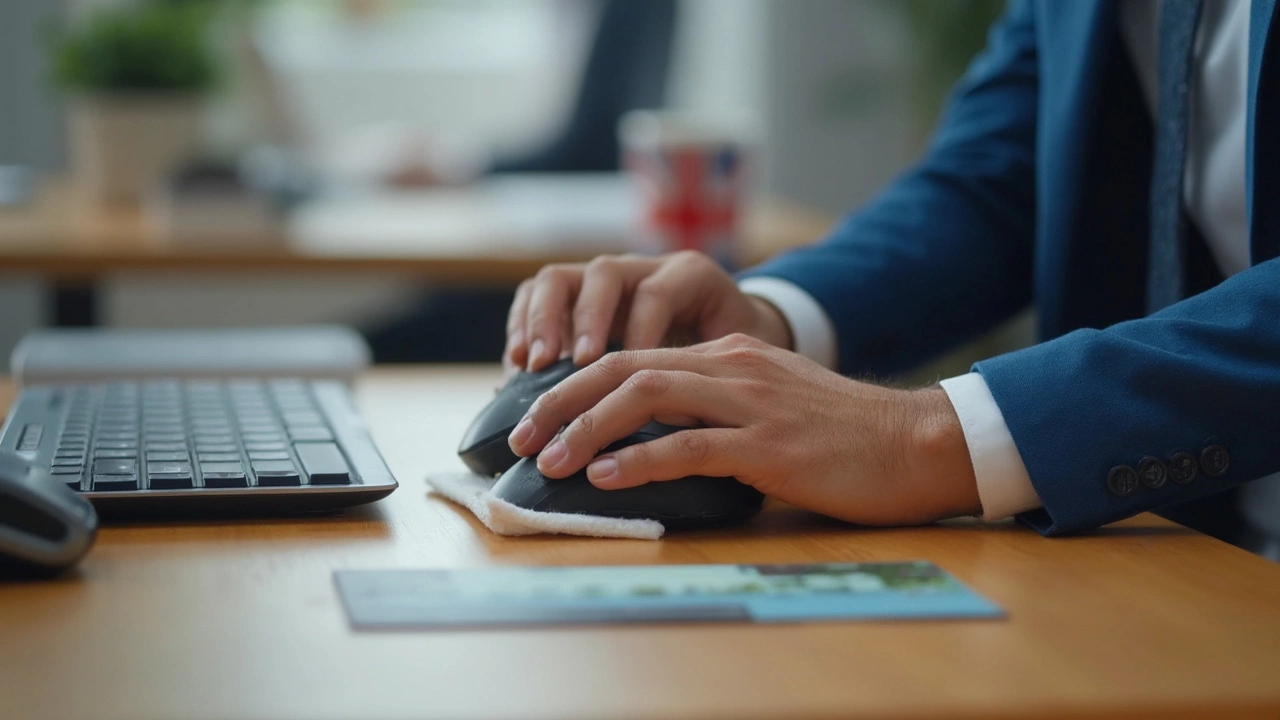You know that moment when you drop your pen and suddenly get a close look under your desk? It’s a jungle down there. Office cleaning isn’t just about making things look nice—it actually keeps you healthier and helps the team get more done. Most germs at work aren’t hiding on obvious spots like the toilet handle—they’re right on your keyboard, mouse, and phone. Makes you squirm a little, right?
The trick with office cleaning is to make it doable. Don’t try to do everything at once, or you’ll burn out and end up sweeping dust under the rug (literally). Start with one area, like your desk. Clear away junk, toss old papers, wipe down the surfaces, and suddenly the whole workplace feels a little lighter. Want to keep it easy? Use disinfecting wipes for desk gadgets, microfiber cloths for screens, and a lint roller for fabric chairs. Small tools make a big difference.
- Why Office Cleaning Matters
- Decluttering: The Secret Weapon
- How to Clean Different Office Zones
- Tech and Germs: What Most People Miss
- Easy Routines to Keep It Tidy
Why Office Cleaning Matters
People spend about a third of their lives at work, so a messy office isn't just annoying—it's like living with that pile of laundry you keep ignoring at home. Here’s the not-so-obvious part: a dirty office doesn’t only look bad, it can actually mess with everyone’s health and job performance.
Desks, keyboards, and phones are straight-up germ hotspots. There’s research showing that the average desk has 400 times more germs than a toilet seat. Not kidding—here’s a quick glimpse at where the nasties lurk in a typical office:
| Office Spot | Average Germs per Square Inch |
|---|---|
| Desk | 21,000 |
| Keyboard | 3,295 |
| Mouse | 1,676 |
| Toilet seat | 49 |
This isn’t just an “ick” factor issue. Dirty shared surfaces mean more sick days and lower energy. People are more likely to get colds, the flu, and even stomach bugs when the office is dirty. Not to mention, a tidy office actually makes you and your coworkers more productive and less stressed. Ever try focusing with empty coffee cups stacking up? It just doesn’t work.
There’s also *the* thing bosses care about—first impressions. Whether it’s a client stopping by or a new hire, a messy office screams “we don’t have our act together.” You wouldn’t invite friends over and leave old food sitting around, right? Your workplace shouldn’t either.
Here’s why making office cleaning a habit really pays off:
- Less sickness spreading around (everybody wants fewer sick days)
- Better morale and focus
- Lower stress—clutter is actually linked to higher stress levels
- More respect from visitors and the team
- No embarrassing moments when someone spots that coffee ring that’s been there since winter
Decluttering: The Secret Weapon
If you ever wonder why your productivity sometimes tanks, clutter might be the sneaky culprit. There’s a famous study from Princeton that found too much stuff around distracts your brain and even raises stress. That’s why decluttering is where real office cleaning begins—before you pull out the wipes or vacuum, you need space to work with.
Start by attacking all the visible junk on your desk—old coffee cups, piles of paperwork, tangled chargers. Don’t just shove it into drawers, though. Here’s a quick way to make real progress without feeling overwhelmed:
- Pick one surface at a time—maybe just your desk or a shared table. Don’t try to do the whole office at once.
- Grab three bins or bags: one for stuff to keep, one to toss, and one for things that don’t belong at your workspace (that random coffee mug from the kitchen? That goes in the third bin).
- Sort fast. If you haven’t used something in a month and it isn’t vital, out it goes.
- Go through drawers and cabinets too. Office supplies multiply when you’re not looking. Dump dried-up pens and give away those extra notepads.
Paper can be a beast in offices. Set up a rule: anything worth saving gets scanned and stored digitally, and the rest gets recycled. Skip the “just in case” pile—those are just future headaches.
Refill what you actually need (like the one stapler that works) and give the rest a new home or put it in common storage. The less stuff you have out, the less you’ll need to clean and the easier it is to zap germs and dust out of your office. Decluttering always feels like a chore—but the good news is, once you do it right, regular cleanups are a breeze.

How to Clean Different Office Zones
Instead of just wiping surfaces and hoping for the best, break the job down by area. Each part of the office has its own mess and set of cleaning rules. Here’s how to handle the big ones:
- Workstations: Start with desks and cubicles. Clear everything off, dump the trash, then wipe the top, keyboard, and mouse with disinfecting wipes. Don’t forget the phone—it’s a germ magnet. Vacuum the chair (yeah, they get crumbs too).
- Meeting rooms: Table surfaces and remote controls need a good wipe, since everybody touches them. Erase old whiteboard scribbles, empty any trash, and check behind chairs for forgotten coffee cups.
- Break room and kitchen: Here’s where mold and sticky stuff love to hang out. Empty the fridge each week, toss old food, wipe the handles and counters, and clean sink faucets. Run the microwave turntable through the dishwasher if you can. Garbage bins fill up fast—make sure someone empties them daily.
- Restrooms: These matter more than most people think. Refill soap and paper towels, wipe down counters, clean toilet handles, and use a mop for floors. Switch out trash liners, and make sure toilets actually flush (kids at my house aren’t the only ones who forget!).
- Reception/common areas: Vacuum carpets, dust surfaces, and keep magazines or pamphlets organized. Wipe down doorknobs, especially during cold and flu season.
You might be surprised how quickly germs and dirt build up. According to a recent survey of office workers, over 60% said their desks weren’t cleaned even once a week. Let’s put some numbers out there:
| Zone | How Often to Clean | High-Risk Surface |
|---|---|---|
| Desk/Workstation | Daily | Keyboard |
| Meeting Room | After use | Remote control |
| Break/Kitchen Area | Daily | Fridge handle |
| Restroom | Daily | Faucet handle |
| Reception | 2-3 times a week | Doorknob |
If you want the office cleaning job to last, use a cleaning checklist for each zone. This way, nothing slips through the cracks—because let’s face it, nobody wants to be the coworker who left a gross mug in the sink for a week.
Tech and Germs: What Most People Miss
When was the last time you cleaned your keyboard? If your answer is “never,” you’re definitely not alone. Studies have found that the average office keyboard has more bacteria than a toilet seat—some even say up to 400 times more. Phones, mice, and touch screens are just as bad, if not worse. Makes you rethink that desk snack, doesn’t it?
The real issue is, these tech items get handled all day, but barely ever get wiped down. With so many hands touching the same conference room phone or passing around tablets, germs travel fast in an office setting. Plus, crumbs and grime get jammed under keys and buttons, making things even messier.
Here’s what you shouldn’t skip when cleaning tech at work:
- Unplug gadgets or turn them off before cleaning.
- Use disinfecting wipes (but not soaked ones) for keyboards, mice, and phones. Don’t let liquid drip into anything—tiny amounts are enough.
- For screens, stick with microfiber cloths and special screen-safe sprays. Never use rough paper towels or window cleaner, which can scratch or damage them.
- Shake out keyboards and use a can of compressed air to blast away crumbs or dust.
- Don’t forget headphones and charging cables—wipe them down, too.
Check out the bacteria count for common office gear compared to other surfaces. It’s kinda wild:
| Item | Average Bacteria Count (CFU/sq in) |
|---|---|
| Office Keyboard | 3,000 |
| Office Phone | 25,000 |
| Desk Surface | 21,000 |
| Toilet Seat | 49 |
Bottom line: put extra effort into wiping down anything you touch often. This is where office cleaning pays off, because a clean keyboard and mouse aren’t just about looks—they’re about cutting down sick days. So next time you reach for that shared phone, maybe give it a quick wipe first. That’s how you keep your office cleaning game strong.

Easy Routines to Keep It Tidy
If you want your office to stay clean without putting in hours every week, daily habits are your secret weapon. Studies from the ISSA (the worldwide cleaning industry association) show that regular quick clean-ups reduce office sickness by up to 62%. That’s not just good for health—fewer sick days mean more time for work (and maybe even an extra coffee break).
The real trick? Make cleaning part of everyone’s routine, not just the cleaning crew’s. Here’s how you can do it:
- Office cleaning checklist: Print a simple checklist for tasks like recycling, wiping surfaces, and emptying bins. Keep it taped up somewhere obvious. This keeps things from slipping through the cracks.
- Adopt a "clean as you go" mindset: Wipe down your desk and gadgets at the end of each day. It takes barely a minute and you’ll always start with a fresh spot every morning.
- Split the load: If you work on a team, try a rotating schedule where everyone handles a part of the shared space one day per week. No one gets stuck with all the dirty mugs.
- Have supplies ready: Sticky notes, tissues, and wipes shouldn’t be hidden away. Keep them close. When supplies are handy, people actually use them.
- Declutter Friday: Pick the last 10 minutes every Friday for everyone to toss out outdated papers, clean out drawers, and organize. You head into the weekend without clutter hanging over you.
The CDC flat-out says that "routine cleaning is key to health and productivity at work." In the words of Mark Warner, education manager at ISSA,
"Nothing beats small, consistent efforts—daily routines add up faster than you think and keep offices healthier for everyone."
Don’t wait for things to get gross. With a handful of easy habits, you’ll keep your office running smoothly and avoid the mess taking over.
